We regularly update this article with the latest information pertaining to marketing budgets for manufacturers.
Last update: November 2022
Based on industry-provided research and our own experience, we’ve identified a realistic marketing budget calculation for manufacturing companies who are ready to more fully leverage the internet to generate business.
An Industry In Transition
U.S. manufacturing companies have had their ups and downs in the last ten years. Many were comfortable using traditional marketing methods, specifically trade shows and print media. Their sales teams followed suit, traveling in their assigned territories to meet with prospects and customers, and following up by phone and email.
We saw a slow shift in thinking a few years prior to the pandemic, with an awakening to the role that digital marketing can play in the success of a manufacturing company.
2020 changed everything, and as trade shows and in-person visits were canceled, many manufacturers accelerated their investment in digital marketing in an effort to replace those previously valuable sources of leads and sales. Marketing and sales teams worked together to create vibrant digital media to share with prospects and outdated websites were revamped into lead-generating tools that support salespeople in a virtual selling climate.
While this acceleration into digital may have been born out of necessity, manufacturers experienced success with online channels and are unlikely to give up the gains from digital advertising, even as offline tactics return.
 Those traditional B2B lead generation processes are sometimes less effective, more costly, and more time-consuming. However, there’s something about being together in person that we all enjoy and we see folks flocking to tradeshows like they are family reunions (the fun side of the family) after two years of virtual events. In 2022, manufacturing tradeshows are back and better than ever. (See our post on the 2022 Pack Expo) Our survey and tradeshow conversations reflect the intentions of manufacturing marketers to continue attending and/or exhibiting at tradeshows in 2023.
Those traditional B2B lead generation processes are sometimes less effective, more costly, and more time-consuming. However, there’s something about being together in person that we all enjoy and we see folks flocking to tradeshows like they are family reunions (the fun side of the family) after two years of virtual events. In 2022, manufacturing tradeshows are back and better than ever. (See our post on the 2022 Pack Expo) Our survey and tradeshow conversations reflect the intentions of manufacturing marketers to continue attending and/or exhibiting at tradeshows in 2023.
Given these fluctuations between digital marketing and offline channels, manufacturers are wondering how much should be budgeted for marketing and how to allocate a portion of their budget to digital marketing. And, which marketing channels are most appropriate for marketing a manufacturing company?
Calculate the ideal marketing budget for your business with our calculator.
Use Historical Data As A Basis For Manufacturer Marketing Budgets
f you’re currently evaluating your marketing budget for 2023, first take a look at last year's budget and results. Based on your marketing performance, determine what areas performed well, and cut the areas that did not deliver the results you expected. Talk to both your sales and marketing teams to get input.
Of course, results from 2020 and 2021 must be looked at through a different lens given the dramatic changes that took place. But you should be able to look back at what worked for your company, particularly if you experimented with different tactics to adapt to those circumstances. What gave you the best return on your investment? What tactics generated the most qualified leads?
2023 Manufacturing Marketing Budget be Higher, Lower, or the Same as 2022?
If so, by how much?
Many manufacturers are conservative with their budgets coming out of the pandemic, and even more so given inflation and concerns of a recession since the first quarter. Supply chain and workforce issues persist making it difficult to meet the demands you already have. But it might not be the best move for your business to dial back too much on marketing, especially in the long term.
Nielsen reports that 70% of recessions end in one year and 30% of them end within two quarters. Rather than cutting a marketing budget in the fear of recession, optimize the media mix and invest in channels that are performing well.
Manufacturers who continued to use their marketing budgets in creative ways through the pandemic were often rewarded with impressive results and have increased brand awareness that will benefit them well into the future.
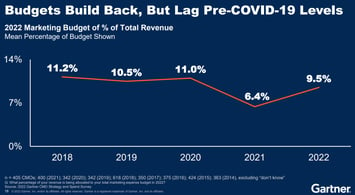 In Gartner's report, The State of Marketing Budgets 2022, after reduced marketing spending in 2021, CMOs have increased marketing budgets in 2022 to 9.5% of revenue; 48% more than in 2021. The manufacturing sector is allocating marketing budgets consistently with the overall trend, at 9.8%; that's also a 69% increase over the previous year.
In Gartner's report, The State of Marketing Budgets 2022, after reduced marketing spending in 2021, CMOs have increased marketing budgets in 2022 to 9.5% of revenue; 48% more than in 2021. The manufacturing sector is allocating marketing budgets consistently with the overall trend, at 9.8%; that's also a 69% increase over the previous year.
What becomes even more essential now is spending marketing budgets very strategically, maximizing marketing dollars where they would have the biggest impact, and bringing in the most qualified leads possible.
Compare Your Budget Against What Other Manufacturing Companies Are Spending
Evaluating what other manufacturing companies are doing can be helpful, though there may be variations from one company to another when considering the size, location, competition, goals, customer mix, and machines or equipment offered.
Until this year, our annual manufacturing budget article reported that the manufacturing industry lagged others in the percentage of revenue budgeted for marketing. But according to Gartner's survey of CMOs, in 2022 manufacturing budgets were 9.8% of revenue, making it one of the higher-spending industries in 2022.
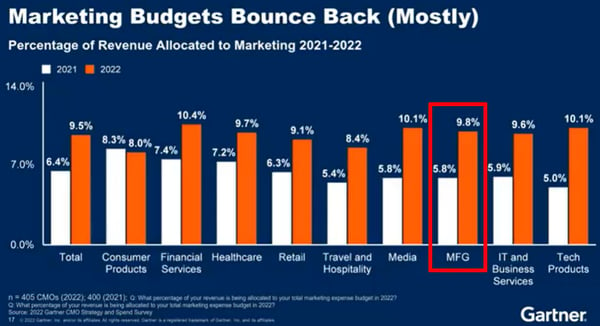
However, a September 2022 survey of 500 U.S. and U.K.-based B2B marketers found that inflation and concerns of an economic recession caused marketers to change their 2022 marketing budgets. It is safe to reason that there will likely be adaptations in 2023 as manufacturers in various industry supply chains will be more or less affected by shifts in demand.
Digital Marketing for Manufacturers
The majority of our manufacturing clients spend between $3,000 per month and $5,000 per month on digital marketing. This includes marketing services - strategy, fresh website content and blog updates, case studies, running Google, Facebook and/or LinkedIn ad campaigns, analytics reporting and analysis, and email marketing. It also includes money for digital advertising - paying Google, Facebook, or LinkedIn for clicks on digital ads. Some companies may need to prioritize replacing their outdated websites before starting any digital marketing efforts.
We continue to see a shift in where marketing dollars are being spent. In the February 2022 CMO Survey, manufacturers planned to allocate 45% of marketing budgets to digital channels in 2022, and 55% to non-digital marketing. This lags behind most other sectors and the all-sector allocation of 56% of the marketing budget to digital channels that Gartner survey reports.
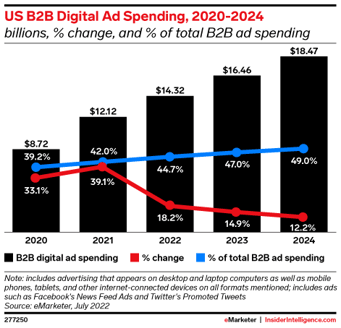
Manufacturers who sell their products online inherently tend to spend more on digital efforts, but even those who do not sell online are moving towards a larger digital presence.
This eMarketer chart from July 2022 indicates that B2B digital ad spending is expected to continue growing through 2024, but the rate of growth is slowing, perhaps due to a finite inventory.
Which Digital Marketing Activities Are Most Effective?
This is a common question we receive, and the answer is "Well, it depends".
Email marketing still leads the way with the highest percentage of Excellent and Good ROI results reported, with social media marketing following closely behind.
Marketing technologies (MarTech) and marketing automation are proving effective at bringing together the most successful marketing tactics (email marketing, organic search, social media marketing, and content marketing) to achieve better results.
For our manufacturing clients, SEO, Content Marketing, and Google pay-per-click ads generate the most website traffic and leads early on.
We have seen excellent results from digital advertising for our manufacturing clients, and often at low costs due to a lack of competition. For manufacturers selling into niche markets, digital ad platforms are the perfect fit, allowing for precise targeting and generating highly qualified leads who are often ready to buy.
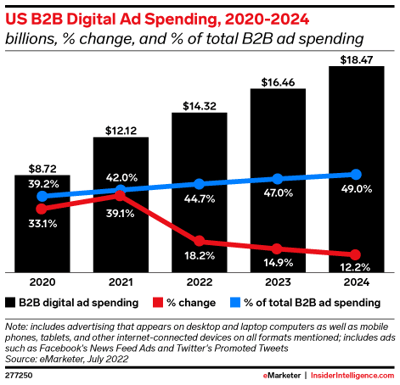
A study from eMarketer released in July 2022 showed this investment in digital advertising as a larger B2B trend. This chart shows growth in digital ad spending among B2B companies that accelerated in 2020 and throughout the pandemic and continues to grow as we emerge from it. While the growth trend slows it continues to grow as a proportion of B2B ad spending.
While Google, YouTube, Facebook, and Instagram tend to dominate advertising platforms in terms of spending, B2B companies have consistently invested a large portion of their advertising dollars on LinkedIn.
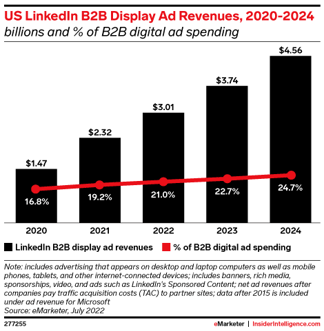 The targeting options on LinkedIn's advertising platform can make it a highly effective option for manufacturers with niche target markets.
The targeting options on LinkedIn's advertising platform can make it a highly effective option for manufacturers with niche target markets.
The chart below from eMarketer shows LinkedIn's market share among B2B companies, accounting for a third of B2B digital display ad revenue.
2023 Manufacturing Marketing Budgets
If you haven't taken a look at your website analytics, marketing, and lead generation results, now is a great time to start. Check out our tips on developing robust dashboard reporting.
You can also start focusing more heavily on identifying your target market—just one or two at a time, and invest in developing buyer personas so your marketing spend can attract the right buyers who need your equipment and products.
Digital marketing has a foothold with manufacturers who have become proactive in adopting a more online-oriented marketing approach.
Check out your competition - I bet they are increasing their online presence and using their website to generate more leads.
Calculate the ideal 2023 marketing budget for your manufacturing company with our exclusive calculator:
You may also be interested in:
Manufacturing Marketing Resources
Best Digital Marketing Tactics for Manufacturers
Manufacturing Marketing: Getting Started with Digital Marketing








Agree, disagree, or just have something to add?
Leave a comment below.